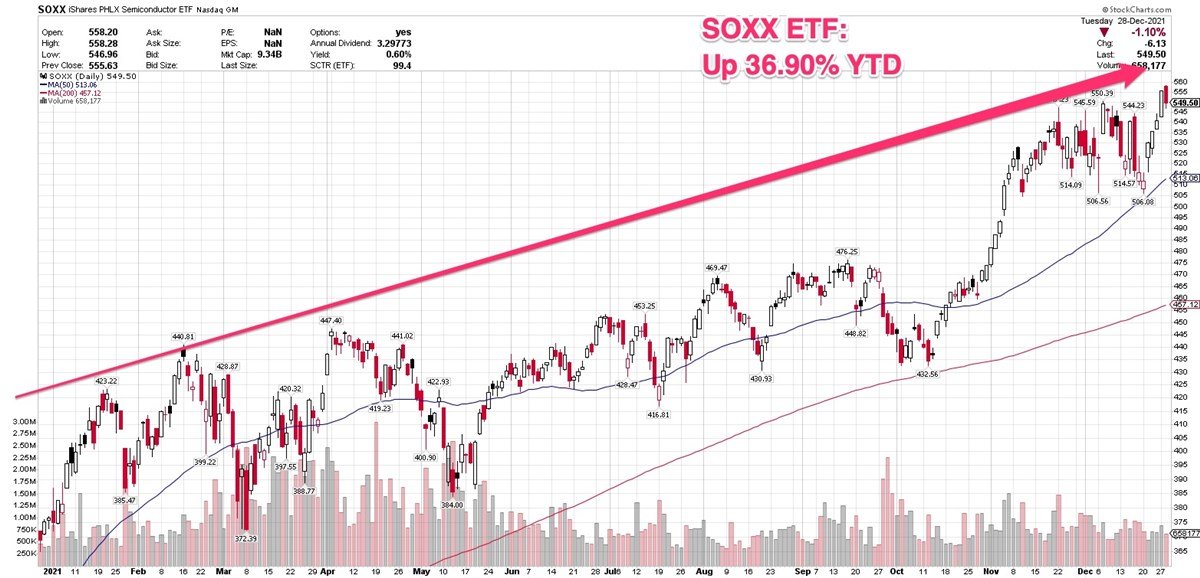The iShares Semiconductor ETF (NASDAQ:SOXX), whose top two components are Broadcom (NASDAQ:AVGO) and Qualcomm (NASDAQ:QCOM), is up 47.59% year-to-date, reflecting strong demand for chips amid the global shortage.
However, even with that stellar performance this year, the index posted even better returns in 2019 and 2020. This ETF tracks the ICE Semiconductor Index (NYSE:ICE), composed of domestic chip stocks.
It’s been outpacing broader tech indexes, notably the S&P large-cap technology index, tracked by the Technology Select Sector SPDR ETF (NYSE:XLK). That ETF is up 36.90% year-to-date.
Index performance is typically driven by that of top components. Broadcom is up nearly 21% this month, its best monthly performance in more than six years. Qualcomm shares are up 2% this month, but that follows a 35.72% uptick in November.
Broadcom
The company specializes in analog chip design for the telecom, industrial, automotive, and computing markets. The stock gapped up 8.27% on December 10, following the company’s better-than-expected fourth-quarter report. Earnings came in at $7.81 per share, a year-over-year gain of 23%. That topped estimates by $0.07, according to MarketBeat data. Revenue was $7.4 billion, up 15%. That also exceeded Wall Street’s expectations. Broadcom beat earnings and revenue estimates in each of the past six quarters, according to MarketBeat data.
The company also increased its quarterly dividend to $4.10 per share, up 14% from the prior dividend. Broadcom also rolled out a $10 billion stock repurchase initiative. In addition, the company issued second-quarter revenue guidance of approximately $6.5 billion, which it said was an expected increase of 13% from the prior-year period. Second-quarter Adjusted EBITDA guidance was approximately 59% of projected revenue.
This year, Broadcom outperformed its industry peers 57.40% vs. 46.91%. The stock is up 34.37% in the past three months. In late August, Broadcom cleared a sloppy consolidation that amounted to a flat base, with a 15% correction. It pulled back briefly, but in mid-October, began a rally that trended well above its 50-day line. It’s repeatedly found support at either its 5-day or 10-day moving average. Broadcom is now extended. But watch for the next moving average pullback, which may offer a buying opportunity.
Qualcomm
The company has been trading in a sideways formation recently, hitting resistance at $192.68 on December 16. In the current consolidation, the stock has been finding support above both its short-term 5-day and 10-day averages.
The stock’s price performance has been outpacing the broader semiconductor industry in the past three months, rising 40.10% vs. 19.96%. It’s also outperforming the semiconductor index during that time. Qualcomm, too, has cheered investors with its dividend increases and positive earnings. The company boosted its dividend in each of the past 10 years. Its dividend yield currently stands at 1.47%, according to MarketBeat dividend data.
High P/E Ratios
Both Broadcom and Qualcomm have high price-to-earnings ratios, at least relative to stocks that aren’t such fast growers. High P/E’s are not unusual in the tech sector or among growth stocks in general, and that shouldn’t make growth investors nervous.
In fact, semiconductor stocks such as Ambarella (NASDAQ:AMBA), Sitime Corporation (NASDAQ:SITM), and Trio-Tech International (NYSE:TRT) have triple-digit P/E ratios. Now, that may be a bit excessive and an indication that a stock is currently priced to perfection. But the point remains: When a stock is in its high growth phase, you’ll often see this ratio race far ahead of where you “think” it should be.
Even a mature stock like Broadcom, which has a high P/E at the moment, has gone through periods of time with lower P/E ratios. For example, in 2011, 2012, and 2013, when the stock essentially traded sideways and even corrected, the P/E ratio was in the low double-digits for over two years.
In other words, semiconductors are a hot sector at the moment. That doesn’t mean you should chase an extended stock (in fact, you should not), but it does mean that a high P/E may be part of the package.

